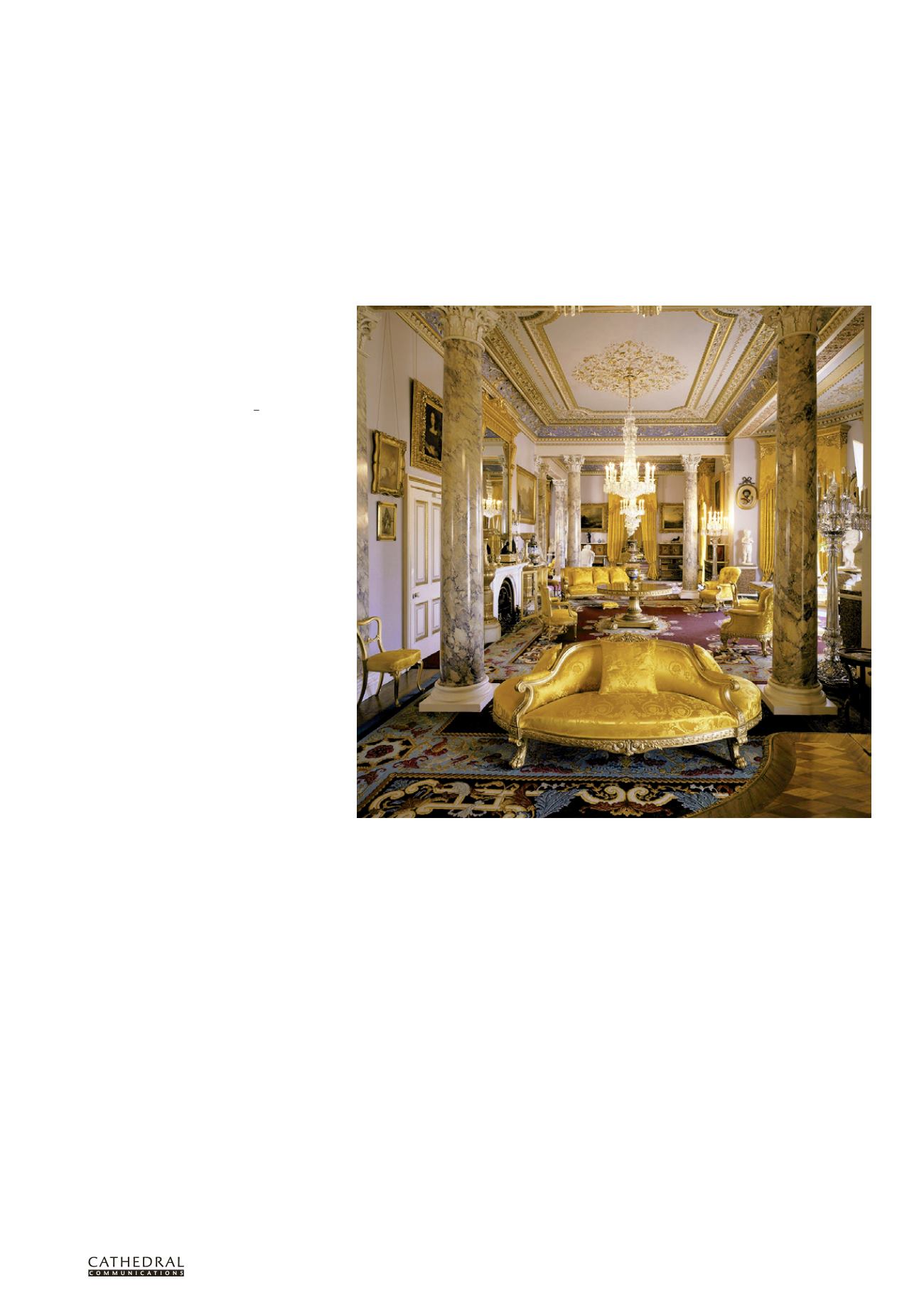

T W E N T Y S E C O N D E D I T I O N
T H E B U I L D I N G C O N S E R VAT I O N D I R E C T O R Y 2 0 1 5
1 6 5
INTER IORS
5
TROMPE L’OEIL MARBLE
History and conservation of 19th-century marbling
FRANCIS STACEY and JANE DAVIES
M
ARBLING IS
a specialist painting
technique that imitates the colours,
patterns and lustre of polished
stones and metamorphosed limestones. It
has been used for many centuries to enrich
the appearance of interior, and occasionally
exterior, architectural elements. It may
have been used when the cost or weight of
genuine stone would have been prohibitive,
but appears also to have enjoyed popularity
as a high quality, visually appealing finish in
its own right.
This article briefly describes the history of
painted marbling, but focusses principally on
the use, techniques and conservation of 19th-
century marbling.
HISTORY
Marbling has a long history and many
examples survive from the classical period,
including a number at Pompeii. In the UK,
archive references from the medieval period
onwards record the extensive use of marbling
to decorate palaces, grand houses and places
of worship. It was a popular baroque motif
during the 17th century and was frequently
applied to columns, pilasters, pedestals,
chimneypieces, wainscots, door architraves
and staircases.
Marbling declined in popularity during
the first half of the 18th century but was
reintroduced during the late 18th and early
19th centuries. It became very widely used
during the 19th century and even today
thousands of humble Victorian terraced
houses retain marbled panels as part of their
original fireplaces. Grander buildings often
contain examples of more impressive features
including entire
‘
marbleised
’
staircases
–
an
early example, from the beginning of the
19th century, can be seen at Sir John Soane
’
s
Museum, Lincoln
’
s Inn Fields, London.
Marbling techniques grew in
sophistication over time. Very early examples
tend to use opaque colours and are decorative
allusions to patterned stone as opposed to
trompe l
’
oeil
illusions. The primary intention
was perhaps to add a sense of opulence,
enlivening surfaces with colour and pattern,
rather than to imitate the fine detail of stone.
By the mid-19th century, however, examples
using diluted opaque paints and transparent
glazes applied with a variety of brushes and
subtly manipulated with feathers, leathers and
rags, were being produced which could pass
for real stone, even to an experienced eye.
During the 19th century, artist decorators
who specialised in
faux
painting techniques
could earn substantial sums and great status
through commissions from wealthy clients
and their work could receive plaudits from
civic and professional bodies. For example,
apprentice decorator Thomas Kershaw
(1819–98) saved enough to purchase specialist
painting tools and moved from Lancashire
to London in 1845. He won first prize for his
marbling examples at the Great Exhibition in
1851, and gold medals at the Paris
Exposition
Universelle
of 1855 and the International
Exhibition of 1862. Kershaw set up his own
firm and won numerous commissions
including marbling at Buckingham Palace
and Osborne House. He became an elected
liveryman in The Worshipful Company of
Painter-Stainers, was granted the Freedom
of the City of London in 1860 and died a
prosperous gentleman. Examples of his work
can still be seen on the staircase to the British
Galleries in the V&A Museum and at Bolton
Museum, Lancashire.
19th-CENTURY TECHNIQUES
Decorative marbles were categorised
by various types, the main ones being:
laminated, brecciated, crinoidal, serpentine
and variegated. Each has its own distinctive
range of shades and textures and many are
naturally decorated by colourful veining or
the inclusion of fossils.
By the 19th century, students were expected
to study geological specimens to produce
imitations that were as realistic as possible.
As the best quality marbling was intended to
be highly naturalistic, painting techniques
evolved which relied on the use of transparent
layers to create visual depth. Writing in 1878,
the master painter-decorator AR Van der Burg
commented:
‘
the marble-painter must take it
as a fundamental rule that marble, the colour
of which is transparent, can only be imitated
by glazing or some similar process
’
.
For marbling to have the waxy sheen
associated with polished stone, the surfaces
The Drawing Room, Osborne House: the specialist decorator Thomas Kershaw is known to have undertaken
marbling here. (Photo: English Heritage)
















